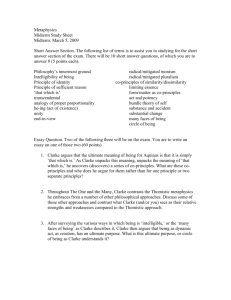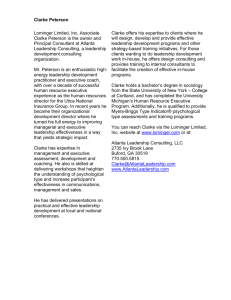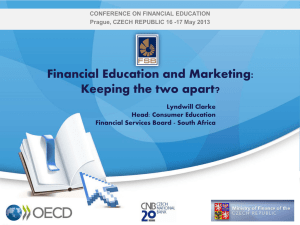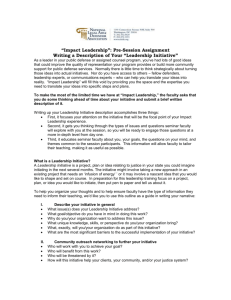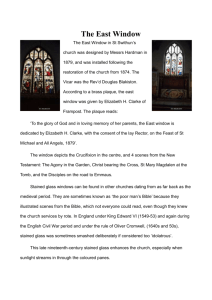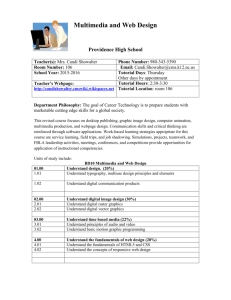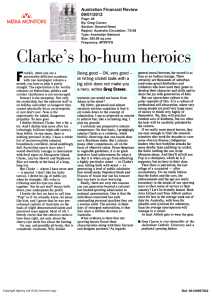Document
advertisement
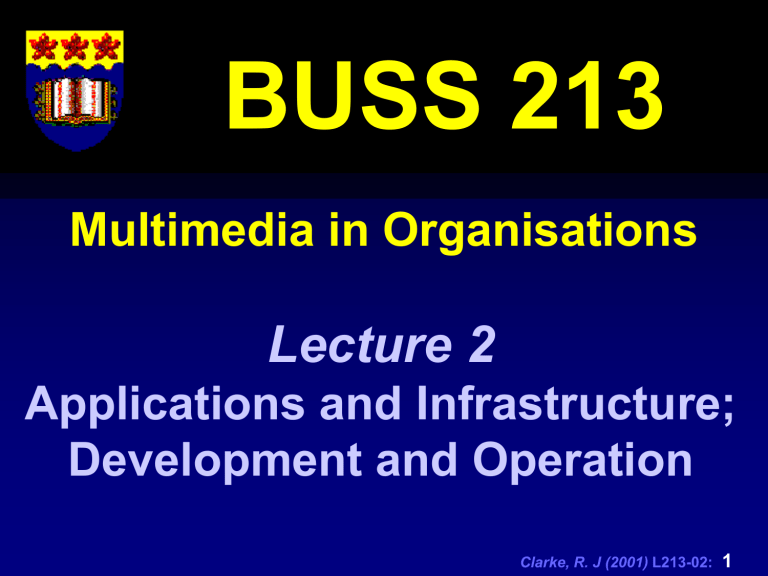
BUSS 213 Multimedia in Organisations Lecture 2 Applications and Infrastructure; Development and Operation Clarke, R. J (2001) L213-02: 1 Notices (1) General Make sure you have a copy of the BUSS213 Subject Outline and Please check the class role on the Departmental Notice Board or on my door for your allocated tutorial slot BUSS213 is supported by a website, where you can find out the latest Notices and get Lecture Notes, Tutorial Sheets, Assignments etc www.uow.edu.au\~rclarke\buss213\buss2131.htm this week tutorial sheet is available on this site for use in the laboratory (open up WORD or simply print it out) your first assignment will be available from this site at about 3:30pm today! Clarke, R. J (2001) L213-02: 2 Notices (2) Tutorial Allocation … most of you are now enrolled in a tutorial, your tutorial allocation is posted on the department notice board on the second floor of Building 40 Students allocated to Tutorials 1 to 3 inclusive (i) nominated for that group and had reasons for being their or nominated that group and did not have a reason but were lucky enough not to be selected for Tutorial 4. Students allocated to Tutorial 4: (i) elected to go to that tutorial, or (ii) enrolled in the subject but did not turn up to the first weeks lecture and indicate their preference, or (iii) a random selection of students who indicated a preference to other tutorial but gave no reason for being allocated to that group Clarke, R. J (2001) L213-02: 3 Notices (3) … Tutorial Allocation some of you do not yet have a tutorial- if you do not then please see me in the break so that you can be temporarily assigned a space (have your student card ready) there is no guarantee that we can accommodate you in a tutorial- as you are aware this class has double the number of students you might want a different tutorial to the one that you in, however due to large numbers of students we cannot consider movements between tutorials at this time Clarke, R. J (2001) L213-02: 4 Agenda (1) in this lecture we want to identify the organisational implications of this type of media- we therefore consider the following topics: What are considered organisationally relevant multimedia applications? (at least in this subject) What organisational infrastructure is required for various kinds of multimedia? How do we approach multimedia development? What operational contexts are required for multimedia to be used Clarke, R. J (2001) L213-02: 5 Agenda (2) the easiest of these questions is: What are considered organisationally relevant multimedia applications? however the answer is still complex! the rest of these questions are touched on briefly. Some questions are discussed in more detail in other lectures: What organisational infrastructure is required for various kinds of multimedia? (Lecture 11) How do we approach multimedia development? (Lecture 12) What operational contexts are required for multimedia to be used (Lecture 10) Clarke, R. J (2001) L213-02: 6 Applications Clarke, R. J (2001) L213-02: 7 Multimedia Applications (1) Vaughan (1998) suggests four areas where multimedia can be found: Business Public Places Schools Home we consider only the first two of these only in this subject and exclude institutional uses of multimedia like education, and we will also exclude the so-called home market which is often motivated by educational imperatives Clarke, R. J (2001) L213-02: 8 Multimedia Applications (2) Multimedia Portfolios (for corporate partners) Workplace Descriptions Architectural Planning Multimedia Systems Analysis and Design Work Evaluations Quality Reviews, Quality Circles Internal Skills Training and Upgrade Organisational Promotion (extranets, internets) Knowledge Provision (intranets) Information Gathering (Video conferencing) can you suggest others? Clarke, R. J (2001) L213-02: 9 Development Clarke, R. J (2001) L213-02: 10 Development for non trivial projects, it is likely: that not all of the skills will be available in the client organisation to create and develop each type of media and to integrate them together also likely that the tools will not be available within the client organisation either an example from our (Dr. Clarke and Schafe experience) in developing an educational title for BHP is a sobering reminder- we will run through some of the issues that effected… Clarke, R. J (2001) L213-02: 11 Development Team Skills Multimedia Team (Vaughan 1998) Project manager Multimedia designer (Computer Graphics Artist, Graphic Designer) Interface designer Writers Video Specialist (Video editing on Media 100 NLE) Audio Specialist Multimedia Programmer Web Site Producer (optionalfor advertising the product or building a hybrid title) and others… Virtual Reality production Stills Photography Audio Processing (Audio-Pro Tools) Systems Integration Educational Consultants Scanners Field Assistants (indexing media, field notes) Production Supervisors, Accountants, Administrators Client Team Site Managers Site Trainers Technical Advisors Clarke, R. J (2001) L213-02: 12 Development May need to hire requisite Skill Set… Need aerial shots of a factory site? You’ll need a helicopter! Need helicopter shots? You’ll need a ‘Continental Mount’! Need to see what’s going in a dark environment without the use of additional lights? You may need analogue – yes that’s right – broadcast quality cameras! Need wide views of action sequences in the workplace? Need wide angle video lens! Need to move the camera from one position to another smoothly? You’ll need a dolly! Need narration? You’ll need to find a voice actor, then you’ll need to make sure you are aware of the appropriate Union Award that covers them and get them to sign the release form- Use an appropriate Solicitor! Clarke, R. J (2001) L213-02: 13 Development …May need to hire requisite Skill Set Need to move the camera around over longer distances (>3 metres) than are available with a dolly? You’ll need a ‘Steadicam’ unit! Need a Steadicam unit? You’ll need a specially trained operator to use it! Want to save money on broadcast quality video by using cheaper analogue and digital video? You’ll need a video specialist trained in the use of Media Cleaner… etc Want to make sure the product doesn’t date? You’ll need a hybrid development that uses the web for updates and the CD-ROM for other media! Want to get the software to do this for you? You’ll have to write it yourself or hire programmers to do it! Want to use existing material? You’ll need to locate the material, you’ll then need to get a copyright author in order to obtain the right to use permission to use it! Clarke, R. J (2001) L213-02: 14 Development Design Trajectories… You may want to develop a multimedia title but you might end up doing a research project several examples from the BHP project followwe wanted to: compress large texts into a small screen ‘real estate’- involved developing in Director the equivalent of what is called the ‘Origami Editor’ to make best use of the editor the texts had to be designed into ‘chunks’- in order to do this sensibly linguistic theory needed to be found, tested, written into procedures and applied to each text Clarke, R. J (2001) L213-02: 15 Extended Text Control Collapse/Expand Sections (2): Text Tabs Clarke, R. J (2001) L213-02: 16 Extended Text Control Collapse/Expand Sections (4): Hyperlinks Clarke, R. J (2001) L213-02: 17 Development …Design Trajectories… we then wanted to support hyperlinks in the textmuch of the editor had to be redesigned and coded (development was not commutative- development sequence was not reversable) bi-directional links between media- click inside an image and a tab containing relevant information is highlighted, click on the tab and the appropriate image regions is highlighted the number of possible events generated in this project meant that a special event manager had to be written to improve the performance of the system Clarke, R. J (2001) L213-02: 18 Development …Design Trajectories to show unfamiliar sequences of action from multiple points of view a new interface widget (control) needed to be developed (designed and programmed that could be used of this purpose) to modularise the content a set of templates needed to be developed- they needed to be designed to work together Clarke, R. J (2001) L213-02: 19 Development New Widget: Digital Video Template Clarke, R. J (2001) L213-02: 20 Clarke, R. J (2001) L213-02: 21 Development User Friendly Access (Navigator) used to select major options and sub-options within a site. It consists of three components: stage (options annulus) where coloured options are available for selection but unvisited, while gray options are either system related or have been recently visited. a centre stage upon which a human figure called an actor stands Clarke, R. J (2001) L213-02: 22 Development Design Trajectories & Dev. Approach… in order to develop effective organisational multimedia you need to be able to involve the users this can improve: the development of the system its usability and comprehensibility promotes ownershop by the participants in the project Clarke, R. J (2001) L213-02: 23 Development Suggested by Users: Safety Gear Button Clarke, R. J (2001) L213-02: 24 Development …Design Trajectories & Dev. Approach … the point is that design especially multimedia design has a ‘trajectory’… when you start changing how one part of an multimedia title works at a fundamental level, other aspects will likely need to be changed… often these changes are not reversable you need to start again… this has an effect on how development occurs this is why many multimedia developers should use what is called evolutionary prototyping or incremental development (see Lecture 12 also BUSS316 which describes different approaches to development including systems development prototyping) Clarke, R. J (2001) L213-02: 25 Development Preferred Development Approach many multimedia developers still persist in thinking that multimedia titles can be completely pre-planned (so-called pre-specified) the way you have been taught classical systems analysis, design, and programming in my experience this does not work for multimedia projects you do not know in advance the exact specifications of the multimedia system before you have undertaken the project design issues and considerations emerge as the project develops therefore it requires very strong project management- not less Clarke, R. J (2001) L213-02: 26 Development Modularise development using Prototypes modularise the development situation into distinct subsystems each of which becomes a prototype- in effect its own system development project clearly specify the interfaces between each of these prototypes, then use the system scope provided by the prototypes to determine the collection or development media eg/: the next two slides show the three BHP project prototypes and some actual planning data with respect to developing virtual reality media Clarke, R. J (2001) L213-02: 27 Relevant Sites and Scope Supply Process/ Material Flow/ Repairable Stock Item S2: Warehouse S1: Slab Caster S1.1 Slab Caster Office S2.1 Stock*Man System Room S2.2 Warehouse Control Room Supply Process/ Info Processing Flows S3: Computer Centre Clarke, R. J (2001) L213-02: 28 Possible/Required QTVRs Site Type Site Name No. Develop. Nodes Priority System Sites S3 S2.1 Computer Centre 32/2 Stock*Man System Room 2 1 2 Warehouse Control Room 4 Slab Caster Office (SAP) 8\2 3 4 Repairable Stock Item 5 Work Sites S2.2 S1.1 Plot Device - 1 Clarke, R. J (2001) L213-02: 29 Development (Some Steps Not a Methodology) Developing initial ideas Developing detailed design Generating media elements Designing or redesigning workflow Integrating, testing, maintaining Clarke, R. J (2001) L213-02: 30 Development Difficulties the most appropriate model for hypersystems development- still up for debate! Production models often follow conventional media Often the technical aspects of programming are tacked onto these media workflows Computer people and media people often don’t understand each other Designers are fuzzy and illogical, programmers are propeller heads Clarke, R. J (2001) L213-02: 31 Development Uses of Storyboarding Vocabulary between these two groups is completely different- Technical versus creative divide! Part of it is embedded in the media (linear media for video; non-linear media for computer programmer) Media people are oriented to completing the product, software people are oriented around versions Often the best way of orienting the two groups is by storyboarding (Pelle Ehe Design of Work Artifacts) Clarke, R. J (2001) L213-02: 32 Operation Clarke, R. J (2001) L213-02: 33 Operation Contribution of Industry Trends- Hardware necessarily how we use multimedia in workplaces is changing very rapidly it is being fueled by industry trends which include: changes to the PC itself: ubiquity of CD-ROMS and the ready availability of DVDs in new machines)- in 1991 we were talking about the advent of multimedia PCs (MPCs) this debate is now irrelevant increased capacity with respect to primary storage (fixed hard disks) and secondary storage (ready availability of ZIP drives for example) Clarke, R. J (2001) L213-02: 34 Operation Contribution of Industry Trends- Software it use to be the case approximately 10 years ago, that if you wanted a multimedia title on a PC you had to build the C libraries to enable parts of the system to work Luther, A. C. (1991) Digital Video in the PC Environment McGraw Hill Johnson, N. (1987) Advanced Graphics in C Programming Techniques McGraw Hill now whether you love them or hate them there are tools around that don’t require this kind of ‘rocket science’ and are relatively easy to learn Clarke, R. J (2001) L213-02: 35 Operation Contribution of Industry Trends- Software the tools are getting easier to use- for example the forthcoming Media Plant system being developed in the School of Education, UOW (to be released next year) was used to develop educational titles which have become award winners for example, one title called Stage Struck enables high school students to create there own play populated with digital actors, dialogue etc. it is such an amasing title it one a BAFTA (British Academy Awards), and in the world Multimedia Awards beat Microsoft Encarta! Clarke, R. J (2001) L213-02: 36 Operation Updates Do you update content? How do you update content? How do you know when to update content? these questions are being solved through the use of hybrid delivery approaches lots of video- place it on a DVD- make sure the title is internet aware- write the system so that it checks a live site that has a list of the latest text and image media to download- arrange for the downloads (to hard disk) to occur in order to replace outdated material- the knows to read material from the users hard disk rather static media Clarke, R. J (2001) L213-02: 37 Operation Communicative Hypersystems Allow the hypersystems to be communicative ie/ add email capabilities to an operational website so that users can contact domain specialists Allow users to talk to each other and learn more about the multimedia title and the application domain it has been built to support- build communities Allow users to actually alter the contents of the material or to add new content- a large range of interactive options are possible Clarke, R. J (2001) L213-02: 38
